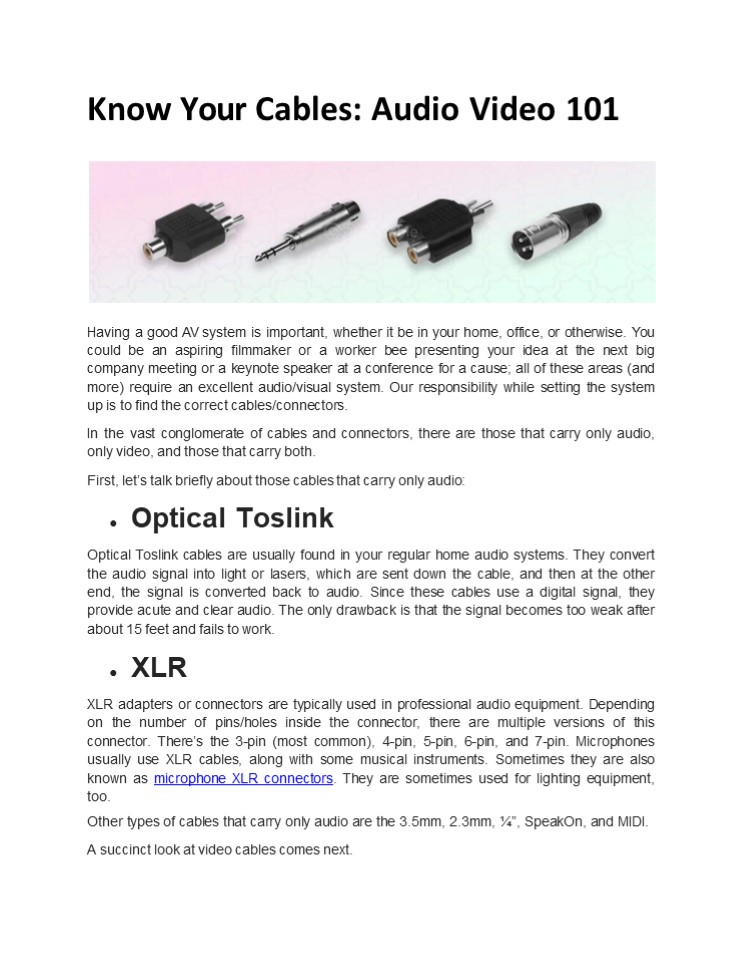Know Your Cables: Audio Video 101 - PowerPoint PPT Presentation
Title:
Know Your Cables: Audio Video 101
Description:
A brief guide on some important audio and video cables to understand which is used for what purpose. This can also help set up an efficient system with valuable information. – PowerPoint PPT presentation
Number of Views:1
Title: Know Your Cables: Audio Video 101
1
Know Your Cables Audio Video 101
- Having a good AV system is important, whether it
be in your home, office, or otherwise. You could
be an aspiring filmmaker or a worker bee
presenting your idea at the next big company
meeting or a keynote speaker at a conference for
a cause all of these areas (and more) require
an excellent audio/visual system. Our
responsibility while setting the system up is to
find the correct cables/connectors. - In the vast conglomerate of cables and
connectors, there are those that carry only
audio, only video, and those that carry both. - First, lets talk briefly about those cables that
carry only audio - Optical Toslink
- Optical Toslink cables are usually found in your
regular home audio systems. They convert the
audio signal into light or lasers, which are sent
down the cable, and then at the other end, the
signal is converted back to audio. Since these
cables use a digital signal, they provide acute
and clear audio. The only drawback is that the
signal becomes too weak after about 15 feet and
fails to work. - XLR
- XLR adapters or connectors are typically used in
professional audio equipment. Depending on the
number of pins/holes inside the connector, there
are multiple versions of this connector. Theres
the 3-pin (most common), 4-pin, 5-pin, 6-pin, and
7-pin. Microphones usually use XLR cables, along
with some musical instruments. Sometimes they are
also known as microphone XLR connectors. They
are sometimes used for lighting equipment, too. - Other types of cables that carry only audio are
the 3.5mm, 2.3mm, ¼, SpeakOn, and MIDI. A
succinct look at video cables comes next.
2
- VGA
- VGA stands for Video Graphics Array. Its
old-tech, used to make analog connections. Its
maximum resolution is 640 x 480, which is lower
than a lot of new types of cables. Nowadays,
laptops and TVs are not made with VGA ports,
although some computer manufacturers still
include them. - DVI
- DVI (Digital Visual Interface) is a little more
complicated than your standard video cables only
because there are various versions to choose
from, and for the video to be seamless, you must
know exactly which one you want. DVI is divvied
into three types DVI-A, DVI-D, and DVI-I. DVI-A
transmits only analog signals DVI-D transmits
only digital signals DVI-I is a combination of
the two and transmits both analog and digital
signals. - The other cables that carry only video signals
are S-Video and DB9. Finally, lets talk about
cables that carry both - F-Type
- These types of connections are coax cable
connectors, mostly used to connect to the back
of TVs. The same F-type comes from the metal
connector, which is found at the end of that
cable. The standard connector is threaded and
screwed on to hold itself. This can also be
found in a push-on version that slides into
place. There are a few different alternatives
when it comes to attaching the connector. The
F-type connectors are available in twist-on,
crimp, and compression. You would need various
tools to build the cable, depending on the
variant you use. - RCA
- Since Radio Corporation of America was the first
company to design and introduce the product to
the world, these particular cables are called RCA
connectors. - The generation before this one used to have CD
players and DVD players that they would want to
connect to their TVs. This was technology before
streaming services, so they had to make these
connections using cables. This is where RCA
cables came into play a regular RCA cable
consisted of three color-coded plugs extending
from the player to the corresponding color-coded
jack on the back of the TV/projector/output
device. The typically analog signals leaving or
entering devices connected via these cables go
through three different channels - two for audio
and one for video - making it a high-quality
transmission.
3
These cables are only able to carry unbalanced
signals, so they are used for only
short-distance transmissions, commonly used in
record player turntables and home theater
systems.
- HDMI
- HDMI stands for "High Definition Multimedia
Interface. HDMI is the new norm for all
audio/visual connections. HDMI is the complete
180 of RCA HDMI is completely digital, while
RCAs are fully analog. There are different types
of HDMI. Type A is the type commonly used in
TVs and computers. Type C, more commonly known
as Mini-HDMI, is used in devices smaller than
TVs/computers like tablets and some laptops. And
finally, there is Micro-HDMI, which is Type
D, which is seen in small devices, especially
phones. - The other cables that carry audio and video
signals are BNC, Component, and DisplayPort. - Now that you have all the information you need
concerning a plethora of audio-visual cables, it
will be a little easier for you to buy one should
you ever need to. One must have the proper audio
cable that goes with its video cable counterpart
if you wish to use separate cables for them or
the correct AV cable, which does the work of
both. This ensures that your presentation,
pitch, and feature film run smoothly. - We have all of the cables listed above and then
some. Please reach out to us if you need help
figuring out which one you need for your setup. - Source https//www.sfcable.com/blog/audio-video-c
able-guide































